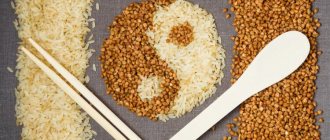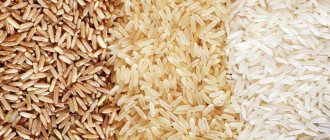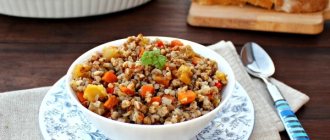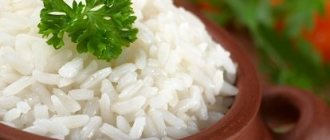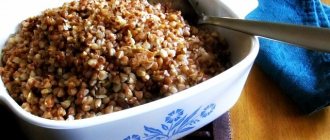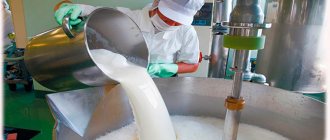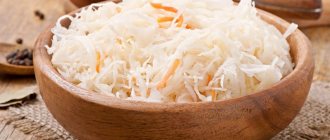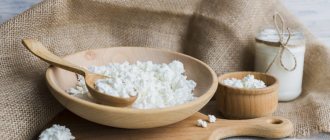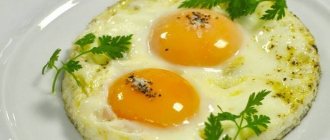Cereals are the most important source of energy; they contain a huge amount of microelements, vitamins and protein. They quickly suppress hunger by reducing the consumption of other foods that may contain harmful components: sugars or fats.
I am pleased with their low calorie content. Looking at the table, you can single out oatmeal and buckwheat as the lowest in calories, but in other types the calorie content is not too high. It is recommended to include cereals in the diet daily, especially for people with intestinal problems and diseases of the cardiovascular system.
The benefits of cereals for the human body
Due to the high fiber content in cereals, the process of glucose absorption slows down and blood sugar levels are normalized. Scientists have proven that they have a low glycemic index and recommend including them in the menu for people with diabetes.
Whole grain products are the most beneficial. There are fewer vitamins in crushed, polished and crushed cereals , since some of them are lost during processing. But there are also those that do more harm than good.
| Name | Benefits for the body | Possible health hazards |
| Corn |
| |
| Rice |
| |
| Semolina |
|
|
| Buckwheat |
| |
| Millet |
| |
| Wheat |
|
|
| Pearl barley |
| |
| Oatmeal |
| . |
| Hercules |
| |
| Fast-cooking oatmeal flakes |
| |
| Barley |
|
Calorie content of millet porridge
Millet porridge is simply irreplaceable for those who want to lose excess weight. The point here is not how many calories are in the porridge with water, but the lipid effect. These beneficial substances included in their composition help remove fat accumulation and slow down the absorption of incoming fat. Thus, existing fat accumulations are spent more efficiently, and new ones are deposited more slowly.
In addition, millet effectively removes heavy metal salts from the body and helps restore digestion after long-term use of antibiotics or other gastrointestinal diseases (with the exception of gastritis with high acidity - then you should not consume millet).
For all these reasons, those who have decided to normalize their diet may be interested in how many calories are in millet porridge with water. A serving of plain millet in water with a little salt (100 g) contains only 90 kcal. Moreover, almost 80% comes from healthy, “complex” carbohydrates. The protein content in such a serving is 14%, and fat is only 7%, so millet porridge can confidently be called a dietary dish.
Nutritionists advise adding pumpkin and carrots to millet porridge.
How many calories are in wheat porridge with water also depends on the additives that are used to improve the taste of the dish. Millet porridge contains a lot of unsaturated fats, which improve the absorption of vitamin D and carotene. For this reason, nutritionists advise adding pumpkin and carrots to millet porridge. The combination of millet and pumpkin is considered the most successful, since the first component prevents fat deposition, and the second accelerates metabolism.
Calorie content per 100 g of different types of cereals in dry form
Cereals contain a large amount of slow carbohydrates, providing long-lasting satiety. Any carbohydrate food, if consumed without moderation, contributes to weight gain, so you should track the calorie content of cereals using a cheat sheet.
| Groats | Kcal per 100 g |
| Round rice | 350 |
| Long rice | 345 |
| Golden rice | 347 |
| Rice for sushi | 341 |
| Rice Brown | 337 |
| Millet | 346 |
| Semolina | 337 |
| Corn | 330 |
| Pearl barley | 322 |
| Barley | 320 |
| Wheat | 314 |
| Buckwheat (kernel) | 311 |
| Buckwheat (done) | 305 |
| Oatmeal | 303 |
The table shows that the most high-calorie cereals are rice, millet and semolina, while oatmeal and buckwheat occupy the last rows. They are ideal for dietary nutrition.
Attention! Crushed, steamed and polished cereals lose their beneficial properties during processing, while their calorie content increases. For example, oatmeal has a calorie content of 365 kcal, instead of 303 kcal. Take this feature into account when planning your diet.
The calorie content of a dry product is not identified with the finished dish made from it. During the cooking process, the cereal changes its consistency, and, consequently, its nutritional value. Cooking with milk and adding additional ingredients also increases the calorie content of the finished dish.
Cereals for weight loss
In general, despite the obvious need not only to reduce the calorie content of food while simultaneously adding sports to your life, but also to significantly reduce the number of carbohydrates, scientists do not recommend eliminating this class of organic compounds completely.
This is due not only to their energy function and the inability of some organs (including the brain) to utilize fatty acids: in the case of the central nervous system, these compounds, which form complexes with plasma proteins, are simply unable to overcome customs control at the border of two tissues: blood and nervous.
Carbohydrates in the body are also used as a plastic material: in particular, from protein molecules that have undergone glycosylation processes, complex derivatives of two classes are formed - glycoproteins, which are part of the structure of receptors in various tissues, thereby ensuring the transmission of signals from a variety of biologically active compounds.
That minimum of carbohydrates (about 100 grams), which is indicated for both healthy and obese people, of course should be covered not with simple sugars that instantly enter the systemic bloodstream, but with complex molecules with branched, long carbon chains: it is this intricate structure that makes them necessary pre-enzymatic treatment in the intestinal lumen, thereby slowing down absorption.
However, not all grains - typical representatives of “long-term” carbohydrates - are as innocent as they seem at first glance. When choosing a side dish, it is necessary to take into account their glycemic index (GI), which shows changes in the concentration of glucose in the blood after consuming a certain product. For example, in products made from white flour, as well as in semolina porridge and corn flakes, it is alarmingly high, which can lead to serious metabolic disorders in the future.
The combination of products also plays an important role in weight gain - for example, having an average GI (50-60), oatmeal, to which a spoonful of sour cream and honey was added for breakfast, turns from a questionably healthy product into a real nuclear bomb, aimed primarily at , against the delicate tissue of the pancreas.
In addition, excess carbohydrate foods are associated with an overgrowth of intestinal bacterial flora. By releasing gas during their vital activity and during enzymatic processes, our microscopic residents contribute to an increase in pressure in the lumen of the gastrointestinal tract - and this greatly complicates the secretion of bile and pancreatic juice, leading not only to constipation, but also to indigestion in general.
So, an important corollary can be drawn from this: in addition to taking into account the (albeit approximate) glycemic index, one should not forget about the insulin index (II) - it reflects the rate of secretion and release of this anabolic hormone. This indicator is very significant for dairy products, so the combination of oatmeal porridge and milk is not the most prudent idea.
However, if you still want to treat yourself to carbohydrates (even fast ones), “cover up” their intake with fats: spread nut butter on a piece of apple, and put melted GHI butter in oatmeal. By the way, this will provide you with a much longer feeling of fullness.
Calorie content per 100 g of different types of cereals in finished form
The finished cereal dish becomes more caloric and 3-4 times less nutritious. To reduce this loss, nutritionists recommend boiling cereals in a small amount of water - “al dente”, so they will retain most of the nutrients.
Calorie table for ready-made cereal dishes:
| Porridge | Kcal per 100 g |
| Rice | 80 |
| Manna | 81 |
| Millet viscous | 89 |
| Pearl barley | 108 |
| Corn | 79 |
| Barley | 76 |
| Buckwheat viscous | 100 |
| Wheat viscous | 92 |
| Oatmeal | 85 |
Buckwheat porridge has sharply increased in calorie content compared to the dry product, and barley, rice, corn and oat porridge are the most acceptable for dietary nutrition. Cereals (the table gives calorie content per 100 g of finished dish) here means boiled in water.
Calorie content of buckwheat porridge on water
Buckwheat porridge has an unusually rich composition. Especially high in unsaturated fatty acids and multivitamins. This helps speed up metabolism and lower levels of “bad” cholesterol, which contributes to successful weight loss.
Note! Buckwheat is rich in protein, so it can be a substitute for animal protein for those who decide to give up meat.
Buckwheat is most often boiled in water, only then adding milk if desired. However, buckwheat is tasty on its own and rarely needs any additions. This dish is considered dietary.
Thanks to its composition, buckwheat is actively used for weight loss, even without taking into account how many calories are in porridge with water. The buckwheat diet in its pure form is tough, often inconvenient due to its monotony, but helps to quickly lose weight. Weight loss during the diet is 3-5 kg. If you diversify your diet by adding fruits, vegetables and dairy products in addition to buckwheat porridge, your weight loss will slow down somewhat. But in the near future, such a menu will help you switch to a healthier diet or quickly recover after heavy feasts.
However, not everyone knows how many calories are in buckwheat porridge with water. Like other cereals, the calorie content of buckwheat is quite high - about 355 kcal/100 g. To reduce the calorie content, it is recommended to cook the cereal in more water. This simple measure allows you to “remove” approximately 150 kcal. Salt may be added during cooking. If you add a little of it, the taste of the porridge will be much better, and the calorie content will increase slightly. It is worth noting that a serving of buckwheat porridge is slightly smaller than a serving of oatmeal - approximately 90 g, so the calorie content is generally lower.
To reduce calorie content, it is recommended to cook buckwheat in more water
Calorie content of cereal flakes
Cereal flakes are cooked for only a few minutes, thanks to preliminary heat treatment in production, but they contain much less vitamins than cereals. However, when using micronization (treatment with infrared rays), the overall loss of beneficial properties is small. Such cereals may contain even more valuable substances than homemade porridge.
Nutritionists consider them a healthy product due to the presence of a large amount of fiber and dietary fat. They stimulate the gastrointestinal tract, improve memory and metabolic processes.
| Flakes | Kcal per 100 g | proteins per 100 g | fats per 100 g | carbohydrates per 100 g |
| Wheat | 357 | 15,0 | 7,5 | 47,0 |
| 5 cereals | 350 | 10,0 | 1,5 | 73,0 |
| Corn | 348 | 7,0 | 2,5 | 83,5 |
| Rice | 345 | 7,0 | 1,0 | 76,0 |
| Oatmeal | 343 | 11,8 | 7,1 | 69,0 |
| Buckwheat | 330 | 9,1 | 2,5 | 67,0 |
| Barley | 321 | 9,7 | 3,5 | 79,0 |
| Muesli | 300 | 7,7 | 13 | 56,5 |
| Rye | 297 | 6,5 | 3,2 | 82,5 |
The main consumers of cereal are children and teenagers, so focusing on them, manufacturers glaze or cover them with chocolate, which increases the calorie content of an already high-calorie product many times over.
This also needs to be taken into account when purchasing. Sweet lovers are advised to add pieces of fruit to their cereal flakes. This will improve their taste and satisfy their sweet tooth without increasing the caloric content of the product too much.
Important! Cereal flakes have a high glycemic index. People suffering from diabetes should not use them.
Calorie table for cereals and cereals
© monticello — stock.adobe.com
Share:
No healthy diet is complete without slow carbohydrates. This is precisely the component of nutrition that charges the body with energy for the whole day. However, if you consume even slow carbohydrates, but in large quantities, this will certainly lead to rapid weight gain. That is why the calorie table for cereals and cereals of various brands and manufacturers comes to the rescue. Knowing the calorie content and composition of BJU, you will be able to create the right diet that will help you achieve your goal.
| Name | Calorie content, kcal | Proteins, g per 100 g | Fats, g per 100 g | Carbohydrates, g per 100 g |
| Amaranth | 371 | 13.6 | 7.0 | 69.0 |
| Di&Di amaranth bran with buckwheat | 345 | 19.0 | 5.5 | 55.0 |
| Amaranth bran Di&Di with kelp | 311 | 20.4 | 5.1 | 37.0 |
| Amaranth bran Di&Di with Jerusalem artichoke | 345 | 19.0 | 5.5 | 55.0 |
| Bulgur | 342 | 12.3 | 1.3 | 57.6 |
| Bulgur Yelli with porcini mushrooms | 330 | 14.0 | 2.0 | 64.0 |
| Bulgur cooked | 83 | 3.1 | 0.2 | 14.1 |
| Makfa split peas in bags | 299 | 23.0 | 1.5 | 48.1 |
| Makfa split peas | 299 | 23.0 | 1.5 | 48.1 |
| Agro-Alliance split peas | 350 | 23.0 | 1.0 | 62.0 |
| Mung bean peas Fair Platinum | 312 | 23.5 | 2.0 | 50.0 |
| Peas Mistral Idaho | 317 | 20.8 | 1.4 | 55.2 |
| Peas Mistral Oregon | 327 | 20.0 | 1.5 | 66.4 |
| Passim split peas | 299 | 23.0 | 1.6 | 48.1 |
| Uvelka split peas | 360 | 20.0 | 2.0 | 67.0 |
| Ready breakfast Nestle Kosmostars stars and galaxies honey | 400 | 7.2 | 5.0 | 76.2 |
| Buckwheat Yelli with porcini mushrooms | 290 | 13.0 | 3.5 | 52.0 |
| Green buckwheat for germination | 295 | 10.8 | 3.2 | 54.4 |
| Buckwheat porridge viscous on water | 90 | 3.2 | 0.8 | 17.1 |
| Buckwheat porridge from Yadritsa grains | 101 | 3.0 | 3.4 | 14.6 |
| Buckwheat porridge with milk | 118 | 4.2 | 2.3 | 21.6 |
| Buckwheat porridge with butter | 132 | 4.5 | 2.3 | 25.0 |
| Buckwheat (done) | 306 | 9.5 | 2.3 | 65.9 |
| Buckwheat (kernel) | 313 | 12.6 | 3.3 | 62.1 |
| Buckwheat (kernel) green | 296 | 10.8 | 3.2 | 56.0 |
| Buckwheat Agro-Alliance Elite | 350 | 13.0 | 3.0 | 68.0 |
| Buckwheat Mistral kernel | 353 | 13.6 | 3.3 | 65.0 |
| Buckwheat Passim Altai | 329 | 12.6 | 2.6 | 68.0 |
| Buckwheat semolina Garnets gluten-free | 350 | 12.5 | 2.5 | 70.0 |
| Buckwheat flakes | 330 | 9.0 | 2.4 | 67.0 |
| Buckwheat flakes Makfa | 375 | 8.0 | 3.0 | 79.0 |
| Buckwheat flakes Myllyn Paras | 340 | 13.0 | 1.7 | 67.5 |
| Myllyn Paras buckwheat flakes for porridge | 340 | 13.0 | 1.7 | 67.5 |
| Buckwheat flakes Agro-Alliance | 370 | 11.0 | 2.0 | 74.0 |
| Buckwheat flakes Altai fairy tale | 346 | 12.8 | 3.4 | 66.1 |
| Buckwheat flakes Mistral | 345 | 12.6 | 2.3 | 59.0 |
| Buckwheat flakes Passim | 322 | 9.5 | 2.3 | 65.8 |
| Myllyn Paras 4-grain porridge | 320 | 11.4 | 2.8 | 61.1 |
| 7-grain porridge Matti | 320 | 12.0 | 5.0 | 56.0 |
| Quinoa | 368 | 14.1 | 6.1 | 57.2 |
| Quinoa Mistral | 368 | 14.0 | 6.0 | 64.0 |
| Chickpea cutlets Tasty business | 288 | 20.8 | 1.8 | 49.7 |
| Lentil cutlets Tasty business | 307 | 19.2 | 2.2 | 54.8 |
| Groats Uvelka Druzhba rice and millet | 350 | 8.0 | 1.0 | 77.0 |
| Corn grits | 337 | 8.3 | 1.2 | 75.0 |
| Corn grits Makfa | 328 | 8.3 | 1.2 | 71.0 |
| Makfa corn grits in bags | 328 | 8.3 | 1.2 | 71.0 |
| Corn semolina Garnets gluten-free | 314 | 23.0 | 1.6 | 50.8 |
| Cornflakes | 363 | 6.9 | 2.5 | 83.6 |
| Corn flakes Altai fairy tale | 325 | 8.3 | 1.2 | 75.0 |
| Corn flakes for health Kuntsevo | 390 | 6.5 | 1.0 | 89.0 |
| Couscous cooked | 112 | 3.8 | 0.2 | 21.8 |
| Dry couscous | 376 | 12.8 | 0.6 | 72.4 |
| Couscous Agro-Alliance | 370 | 12.0 | 2.5 | 75.0 |
| Flaxseed porridge with sesame seeds | 312 | 34.0 | 14.0 | 12.0 |
| Flax bran Dr. Dias | 250 | 30.0 | 10.0 | 10.0 |
| Flax bran Dr. Dias with seed | 250 | 30.0 | 10.0 | 10.0 |
| Semolina porridge on water | 80 | 2.5 | 0.2 | 16.8 |
| Semolina porridge with milk | 98 | 3.0 | 3.2 | 15.3 |
| Semolina | 328 | 10.3 | 1.0 | 67.4 |
| Semolina Makfa | 333 | 10.3 | 1.0 | 70.6 |
| Semolina Myllyn Paras | 348 | 12.0 | 2.0 | 69.0 |
| Semolina Agro-Alliance | 330 | 10.0 | 1.0 | 69.0 |
| Semolina with bran BIO Black bread | 340 | 13.1 | 4.6 | 61.5 |
| AXA crispy honey muesli with fruits and nuts | 376 | 7.8 | 13.1 | 56.7 |
| Horeca Select muesli with fruits and nuts | 363 | 11.4 | 7.8 | 56.7 |
| Vitalis fruit muesli | 317 | 7.8 | 4.6 | 61.1 |
| Vitalis chocolate muesli | 400 | 10.0 | 13.0 | 62.0 |
| Muesli Bon | 333 | 8.8 | 5.1 | 62.6 |
| Muesli Wow! baked with banana | 460 | 9.0 | 18.0 | 60.0 |
| Muesli Cereal Age Orchard | 328 | 9.3 | 4.4 | 63.0 |
| Chickpea Agro-Alliance | 390 | 20.0 | 5.0 | 66.0 |
| Chickpea Fair Platinum | 320 | 20.1 | 4.3 | 55.1 |
| Myllyn Paras oatmeal | 350 | 14.0 | 7.5 | 56.0 |
| Oatmeal Myllyn Paras cream flavor with strawberries | 406 | 10.2 | 16.6 | 53.9 |
| Oatmeal Myllyn Paras cream flavor with raspberries | 394 | 10.3 | 14.9 | 54.7 |
| Oatmeal Myllyn Paras cream flavor with blueberries | 410 | 10.7 | 15.0 | 58.0 |
| Myllyn Paras oatmeal with melon | 347 | 10.8 | 5.8 | 62.8 |
| Myllyn Paras oatmeal with melon and sugar | 362 | 11.5 | 7.7 | 61.9 |
| Myllyn Paras oatmeal with strawberries without sugar | 353 | 11.9 | 7.9 | 56.3 |
| Myllyn Paras oatmeal with strawberries and sugar | 362 | 11.9 | 7.9 | 60.8 |
| Myllyn Paras oatmeal with cranberries without sugar | 353 | 11.9 | 7.9 | 56.3 |
| Myllyn Paras oatmeal with wild berries and sugar | 363 | 11.6 | 7.7 | 61.8 |
| Myllyn Paras oatmeal with raspberries and sugar | 362 | 11.9 | 7.9 | 60.8 |
| Myllyn Paras oatmeal with bran, cherries and plums | 333 | 15.5 | 7.2 | 50.6 |
| Myllyn Paras oatmeal with bran, apple and blackcurrant | 333 | 15.2 | 7.0 | 51.1 |
| Myllyn Paras Sugar Free Peach Oatmeal | 353 | 11.9 | 7.9 | 56.3 |
| Myllyn Paras oatmeal with peach and sugar | 357 | 11.6 | 7.6 | 60.7 |
| Myllyn Paras oatmeal with tropical fruits | 348 | 11.1 | 5.8 | 62.8 |
| Myllyn Paras Sugar Free Blueberry Oatmeal | 353 | 11.9 | 7.9 | 56.3 |
| Myllyn Paras oatmeal with blueberries and sugar | 362 | 11.6 | 7.7 | 61.7 |
| Myllyn Paras oatmeal with chocolate and orange | 363 | 10.5 | 8.0 | 62.2 |
| Myllyn Paras oatmeal with apple and lingonberry | 346 | 10.4 | 5.5 | 63.8 |
| Myllyn Paras Tropic oatmeal with sugar | 364 | 11.7 | 7.8 | 61.8 |
| Oatmeal Mistral Raspberry mille-feuille | 347 | 8.8 | 3.1 | 65.2 |
| Oatmeal Mistral Tiramisu | 355 | 9.3 | 6.5 | 65.7 |
| Oatmeal Mistral Blueberry cheesecake | 351 | 9.3 | 6.6 | 64.7 |
| Oatmeal Mistral Apple-Pear | 337 | 10.5 | 6.3 | 56.6 |
| Oatmeal Mistral Berry mousse | 363 | 10.5 | 5.9 | 68.4 |
| Oatmeal on water | 88 | 3.0 | 1.7 | 15.0 |
| Oatmeal with milk | 102 | 3.2 | 4.1 | 14.2 |
| Oat groats | 342 | 12.3 | 6.1 | 59.5 |
| Oat semolina Garnets gluten-free | 342 | 12.3 | 6.1 | 59.5 |
| Oat Semolina Myllyn Paras | 345 | 14.5 | 5.1 | 69.1 |
| Oat + Rice cereal Myllyn Paras | 346 | 10.3 | 4.0 | 68.0 |
| Oat bran | 320 | 18.0 | 7.7 | 45.3 |
| Oat bran Dr. Dias cleansing | 129 | 10.8 | 2.6 | 16.6 |
| Oat bran Myllyn Paras | 320 | 18.0 | 7.7 | 45.3 |
| Oat bran Nordic | 360 | 18.0 | 8.5 | 43.0 |
| Oat bran Diadar crispy | 197 | 13.5 | 4.8 | 25.0 |
| Oat bran Mistral | 346 | 17.8 | 6.9 | 65.8 |
| Oat bran Wow! | 356 | 12.5 | 4.5 | 62.0 |
| Oat bran with blueberries | 118 | 8.0 | 4.0 | 13.0 |
| Cereals | 366 | 11.9 | 7.2 | 69.3 |
| Oat flakes + Bran Myllyn Paras | 335 | 16.2 | 7.6 | 50.0 |
| Oat flakes 4 Life organic | 340 | 14.0 | 6.5 | 56.0 |
| Bruggen Haferflocken whole oat flakes | 372 | 13.5 | 7.0 | 58.7 |
| Makfa oat flakes | 380 | 13.0 | 6.0 | 70.0 |
| Makfa oat flakes with bran | 345 | 14.0 | 5.0 | 62.0 |
| Myllyn Paras oat flakes | 350 | 14.0 | 7.5 | 56.0 |
| Myllyn Paras instant oat flakes | 350 | 14.0 | 7.5 | 56.0 |
| Myllyn Paras large oat flakes | 359 | 14.0 | 7.5 | 56.0 |
| Nordic oat flakes with oat bran | 370 | 15.0 | 8.0 | 53.0 |
| Nordic oat flakes with wheat bran | 360 | 15.0 | 7.6 | 47.0 |
| Oat flakes Hercules | 352 | 12.5 | 6.2 | 61.0 |
| Oat flakes Hercules Makfa traditional | 350 | 12.0 | 6.0 | 62.0 |
| Oat flakes Hercules Agro-Alliance Classic | 310 | 11.0 | 6.0 | 51.0 |
| Oat flakes Hercules Russian product Monastyrsky | 350 | 12.0 | 6.0 | 62.0 |
| Oat flakes Hercules Fitness with bran | 351 | 12.3 | 6.3 | 61.2 |
| Passim oat flakes | 377 | 10.0 | 6.0 | 68.0 |
| Uvelka thin oat flakes | 305 | 11.0 | 6.2 | 50.2 |
| Uvelka traditional oat flakes | 390 | 12.0 | 6.0 | 72.0 |
| Oat flakes Yasno Solnyshko with oat bran | 340 | 11.0 | 7.0 | 48.0 |
| Oat flakes Clear Sun No. 1 | 310 | 12.0 | 6.0 | 51.0 |
| Oat flakes No. 2 Agro-Alliance | 390 | 12.0 | 5.0 | 70.0 |
| Siberian bran Fruit power, crispy balls | 230 | 12.0 | 2.5 | 40.0 |
| Pearl barley porridge on water | 109 | 3.1 | 0.4 | 22.2 |
| Pearl barley porridge, crumbly | 106 | 3.1 | 0.4 | 23.0 |
| Pearl barley | 320 | 9.3 | 1.1 | 73.7 |
| Pearl barley Makfa | 315 | 9.3 | 1.1 | 66.9 |
| Makfa pearl barley in bags | 315 | 9.3 | 1.1 | 66.9 |
| Pearl barley Mistral Barley | 349 | 12.1 | 0.8 | 73.4 |
| Spelled | 337 | 14.7 | 2.2 | 61.2 |
| Spelled porridge on water | 127 | 5.5 | 0.9 | 26.5 |
| Puffed wheat for health! chocolate flavored | 399 | 9.9 | 4.6 | 79.6 |
| Sprouted wheat | 198 | 7.5 | 1.3 | 41.4 |
| Wheat porridge Myllyn Paras | 325 | 13.0 | 2.0 | 62.5 |
| Wheat groats | 316 | 11.5 | 1.3 | 62.0 |
| Wheat cereal Makfa Artek | 329 | 11.0 | 1.2 | 68.5 |
| Wheat cereal Makfa Poltava in bags | 329 | 11.5 | 1.3 | 67.9 |
| Wheat grain Agro-Alliance | 340 | 13.0 | 1.0 | 71.0 |
| Wheat grain Mistral couscous | 350 | 12.0 | 2.0 | 72.0 |
| Soft wheat grains | 305 | 11.8 | 2.2 | 59.5 |
| Durum wheat grains | 304 | 13.0 | 2.5 | 57.5 |
| Wheat bran | 180 | 14.7 | 4.1 | 20.6 |
| Wheat bran Wow! | 326 | 13.8 | 2.8 | 61.4 |
| Nordic wheat flakes | 340 | 11.0 | 2.6 | 61.0 |
| Millet porridge Myllyn Paras | 305 | 11.2 | 3.9 | 55.3 |
| Millet porridge viscous on water | 90 | 3.0 | 0.7 | 17.0 |
| Millet porridge crumbly | 135 | 4.7 | 1.1 | 26.1 |
| Millet cereal | 348 | 11.5 | 3.3 | 69.3 |
| Millet groats Mistral ground | 342 | 11.5 | 3.3 | 66.5 |
| Millet-buckwheat flakes Altai fairy tale | 347 | 12.5 | 3.2 | 66.9 |
| Millet and rice flakes Agro-Alliance | 370 | 10.0 | 4.0 | 73.0 |
| Nordic millet flakes | 334 | 12.0 | 2.9 | 69.3 |
| Elite millet Agro-Alliance | 350 | 12.0 | 3.0 | 69.0 |
| Rye bran | 221 | 11.2 | 3.2 | 32.0 |
| Rye bran Diadar Borodino crispy | 190 | 13.2 | 3.2 | 27.0 |
| Rye bran Wow! | 274 | 13.0 | 2.0 | 40.0 |
| Rye flakes | 343 | 6.4 | 3.2 | 82.6 |
| Rye flakes Myllyn Paras | 305 | 9.7 | 2.0 | 61.3 |
| Yelli risotto with tomatoes and basil | 350 | 7.0 | 1.0 | 77.0 |
| 4 seasons rice for frying | 110 | 2.0 | 0.5 | 22.0 |
| Rice Bravolli Carnaroli for risotto | 360 | 7.0 | 1.0 | 80.0 |
| Makfa long grain rice | 333 | 7.0 | 1.0 | 74.0 |
| Makfa long grain rice in bags | 333 | 7.0 | 1.0 | 74.0 |
| Makfa long grain parboiled rice | 333 | 7.0 | 1.0 | 74.0 |
| Makfa long grain parboiled rice in bags | 333 | 7.0 | 1.0 | 74.0 |
| Makfa short grain rice | 333 | 7.0 | 1.0 | 74.0 |
| Makfa short grain rice in bags | 333 | 7.0 | 1.0 | 74.0 |
| Yelli Basmati Rice with Biryani Vegetables | 350 | 7.0 | 1.0 | 77.0 |
| Rice Agro-Alliance brown Slim&Fit | 380 | 7.5 | 2.0 | 77.0 |
| Rice Agro-Alliance for pilaf | 420 | 6.5 | 9.0 | 79.0 |
| Rice Agro-Alliance for Arborio risotto | 340 | 6.5 | 1.0 | 75.0 |
| Rice Agro-Alliance for sushi and Japanese cuisine | 340 | 8.0 | 0.4 | 77.0 |
| Rice Agro-Alliance Jasmine | 340 | 7.5 | 0.2 | 76.0 |
| Rice Agro-Alliance red Rubin | 340 | 7.5 | 2.0 | 69.0 |
| Rice Agro-Alliance Kuban Elite | 330 | 6.5 | 0.5 | 75.0 |
| Agro-Alliance steamed rice Gold | 350 | 6.5 | 1.0 | 79.0 |
| Rice Agro-Alliance Mix of golden and wild | 340 | 8.0 | 1.0 | 76.0 |
| Rice Agro-Alliance Super Basmati | 340 | 9.5 | 0.2 | 75.0 |
| Rice Agro-Alliance black Southern night | 260 | 6.5 | 2.5 | 52.0 |
| Arborio rice | 330 | 6.5 | 0.7 | 75.4 |
| White rice | 344 | 6.7 | 0.7 | 78.9 |
| Boiled white rice | 116 | 2.2 | 0.5 | 24.9 |
| Brown rice | 337 | 7.4 | 1.8 | 72.9 |
| Wild Rice + Parboild Worlds Rice | 358 | 13.7 | 1.0 | 74.2 |
| Boiled wild rice | 100 | 4.0 | 0.3 | 21.1 |
| Wild black rice | 101 | 4.1 | 0.4 | 21.0 |
| Long grain rice | 365 | 7.1 | 0.7 | 78.0 |
| Rice for sushi | 342 | 7.0 | 0.6 | 75.2 |
| Rice Zhmenka Arborio | 354 | 6.7 | 1.5 | 78.5 |
| Zhmenka long grain rice | 330 | 7.0 | 1.0 | 71.4 |
| Rice Zhmenka Jasmine | 331 | 6.9 | 0.2 | 73.4 |
| Zhmenka round grain rice | 330 | 7.0 | 1.0 | 71.4 |
| Zhmenka rice, unpolished | 285 | 8.0 | 3.9 | 52.0 |
| Rice Zhmenka Selected | 330 | 7.0 | 1.0 | 71.4 |
| Zhmenka steamed rice | 341 | 7.3 | 0.2 | 75.4 |
| Zhmenka steamed rice Gold | 341 | 7.3 | 0.2 | 75.4 |
| Rice Zhmenka Super Basmati | 322 | 7.1 | 0.2 | 71.2 |
| Rice Zhmenka Sushi | 347 | 7.2 | 0.3 | 79.0 |
| Golden rice | 349 | 8.1 | 0.4 | 78.0 |
| Rice Carnaroli | 303 | 7.5 | 2.6 | 62.5 |
| Brown rice | 331 | 6.3 | 4.4 | 65.1 |
| Boiled brown rice | 110 | 2.6 | 0.9 | 22.8 |
| Unpolished red rice | 362 | 10.5 | 2.5 | 70.5 |
| Polished short grain rice | 350 | 0.1 | 0.4 | 79.0 |
| Rice Mistral Aquatica Color Mix | 356 | 8.8 | 2.3 | 72.8 |
| Rice Mistral Aquatica Wild | 357 | 14.0 | 0.5 | 72.0 |
| Mistral round grain rice | 355 | 0.1 | 0.4 | 79.5 |
| Mistral steamed rice | 361 | 7.1 | 0.7 | 79.3 |
| Rice Mistral Samarkand red round grain | 320 | 8.0 | 0.5 | 75.8 |
| Rice National Health | 340 | 7.5 | 2.0 | 73.0 |
| Unpolished boiled rice | 125 | 2.7 | 0.7 | 36.0 |
| Rice Nishiki | 277 | 7.0 | 2.0 | 56.0 |
| Passim round grain rice Primorsky | 333 | 7.0 | 1.0 | 74.0 |
| Polished rice | 330 | 7.0 | 1.0 | 71.4 |
| Rice fluffy | 113 | 2.4 | 0.2 | 24.9 |
| Uvelka round grain rice | 330 | 7.0 | 1.0 | 71.1 |
| Uvelka round grain polished rice | 340 | 8.0 | 1.0 | 76.0 |
| Rice Fushigon | 340 | 7.0 | 0.6 | 77.3 |
| Rice porridge on water | 78 | 1.5 | 0.1 | 17.4 |
| Rice porridge with milk | 97 | 2.5 | 3.1 | 16.0 |
| Garnets gluten-free rice semolina | 340 | 7.0 | 0.5 | 78.0 |
| Rice bran | 316 | 13.4 | 20.9 | 28.9 |
| Rice flakes | 360 | 7.0 | 2.0 | 77.0 |
| Myllyn Paras Rice Cereals | 360 | 7.0 | 1.0 | 77.0 |
| Myllyn Paras rice flakes for porridge | 360 | 7.0 | 1.0 | 77.0 |
| Rye (grains) | 283 | 9.9 | 2.2 | 55.8 |
| Sago | 350 | 1.0 | 0.7 | 85.0 |
| A mixture of 5 types of bran The right remedy | 150 | 15.0 | 4.5 | 15.0 |
| Bravolli soup mix | 330 | 18.0 | 1.5 | 60.0 |
| A mixture of 3 types of bran Myllyn Paras | 255 | 16.6 | 6.1 | 34.1 |
| Mistral Lentil Mix for Soups and Side Dishes | 327 | 24.5 | 1.2 | 54.6 |
| Grain sorghum | 323 | 11.8 | 3.3 | 66.4 |
| Wheat talkan | 324 | 11.5 | 1.3 | 64.0 |
| Talkan-shifa 4 grains | 309 | 10.6 | 2.7 | 60.5 |
| Teff | 367 | 13.3 | 2.4 | 73.1 |
| Oatmeal | 363 | 12.5 | 6.0 | 64.9 |
| Buckwheat oatmeal Your health from stewed grain | 308 | 12.6 | 3.3 | 57.1 |
| Corn oatmeal Your health from stewed grain | 328 | 8.3 | 1.2 | 71.0 |
| Oatmeal Your health | 306 | 11.5 | 6.0 | 52.1 |
| Oatmeal Garnets | 357 | 12.2 | 5.8 | 68.3 |
| Triticale | 274 | 12.8 | 2.1 | 54.5 |
| Beans Agro-Alliance Black Eye (Black Eye) | 340 | 23.0 | 1.0 | 60.0 |
| Agro-Alliance white beans | 350 | 21.0 | 2.0 | 62.0 |
| Agro-Alliance red beans Red Kidney | 350 | 21.0 | 2.0 | 62.0 |
| Myllyn Paras 4-grain flakes | 320 | 11.4 | 2.8 | 51.1 |
| Makfa flakes 4 grains | 360 | 10.0 | 2.0 | 77.0 |
| Makfa flakes 5 grains | 370 | 11.0 | 3.0 | 75.0 |
| Nestle Fitness Whole Wheat Cereals | 357 | 8.3 | 2.0 | 76.4 |
| Nestle Fitness cereal with dark chocolate | 384 | 8.0 | 6.7 | 72.9 |
| Nestle Fitness cereal with fruit | 352 | 6.4 | 2.6 | 75.7 |
| Cereals Agro-Alliance 4 cereals | 390 | 12.0 | 3.0 | 73.0 |
| Cereals Agro-Alliance 5 cereals | 370 | 12.0 | 3.0 | 70.0 |
| Myllyn Paras Red Lentil Flakes | 320 | 25.0 | 0.0 | 52.0 |
| Mistral flakes mixture of 5 cereals | 365 | 10.1 | 3.8 | 76.3 |
| Cereals Passim Three grains | 334 | 10.0 | 3.6 | 63.0 |
| Cereals Passim Four grains | 322 | 10.3 | 3.2 | 61.0 |
| Uvelka flakes 5 grain thin | 360 | 11.0 | 2.0 | 75.0 |
| Cereals Tsar 4 grains | 330 | 11.0 | 2.5 | 66.0 |
| Cereals Tsar 5 cereals | 308 | 10.2 | 1.5 | 73.2 |
| Cereals Tsar 7 grains | 340 | 10.0 | 2.5 | 64.0 |
| Lentils Agro-Alliance red | 350 | 26.0 | 2.0 | 57.0 |
| Lentils Agro-Alliance Elite | 360 | 28.0 | 2.0 | 58.0 |
| Lentils Mistral Canadian green large | 328 | 19.4 | 1.1 | 66.6 |
| Lentils Mistral Persian red split | 322 | 25.0 | 1.1 | 53.0 |
| Lentils Mistral Turkish yellow split | 332 | 22.3 | 0.1 | 65.5 |
| Barley porridge | 310 | 11.5 | 2.0 | 65.8 |
| Barley groats | 324 | 10.0 | 1.3 | 71.7 |
| Barley flakes | 355 | 9.8 | 3.6 | 79.4 |
| Myllyn Paras barley flakes | 320 | 11.0 | 2.0 | 63.0 |
| Barley porridge on water | 76 | 2.3 | 0.3 | 15.7 |
| Barley porridge with milk | 111 | 3.6 | 2.0 | 19.8 |
| Barley grits | 324 | 10.4 | 1.3 | 66.3 |
| Makfa barley in bags | 313 | 10.0 | 1.3 | 65.4 |
You can download the complete table, which will always be at hand at home, in the store, and at a party, right here.
Rate the material
Share:
Author Ivan Tungusov
Project expert. Training experience - 12 years. A good theoretical basis on the training process and proper nutrition, which I am happy to put into practice. Need a recommendation? This is for me 
Editorial team cross.expert
Energy value of cereals boiled in water and milk
The calorie content of cereal dishes varies depending on the method of their preparation: with milk or water. For milk porridges it is much higher, since the calorie content of milk is added to the cereal, the energy value of which after boiling increases by another 8 Kcal.
Calorie table for milk porridges:
| Porridge | Kcal per 100 g |
| Rice | 97 |
| Pearl barley | 150 |
| Barley | 111 |
| Millet | 102 |
| Wheat viscous | 135 |
| Buckwheat viscous | 142 |
| Manna | 105 |
| Oatmeal | 100 |
| Corn | 92 |
Corn, rice and oatmeal milk porridge have the minimum energy value, while buckwheat and pearl barley occupy the first positions in these indicators. Using water for cooking rather than milk will help reduce them. However, nutritionists and gastroenterologists advise not to give up higher-calorie cereals and, when choosing cereals for them, to focus on their benefits, and not on calories.
Calorie content of rice porridge on water
Rice porridge is one of the most popular due to its taste and beneficial properties. It acts as an adsorbent, absorbing and removing harmful substances from the body. Rice porridge helps normalize metabolism and also satisfies well. Therefore, those who monitor their health need to know how many calories are in rice porridge with water.
Calorie content may vary slightly depending on the type of rice.
Tip: Unpeeled brown rice is considered the healthiest. It is best suited for weight loss, since 70% of all nutrients are in the shell.
In general, the calorie content of ready-made rice porridge is about 144 kcal/100 g, which allows the dish to be considered dietary. Eating rice has a beneficial effect on the body and promotes weight loss. So, on a mono diet you can lose about 4 kg in a week. Regular consumption of rice in combination with healthy foods also promotes weight loss. The fiber contained in rice normalizes digestion. In addition, rice grains do not contain gluten, so people with gluten intolerance can consume it. However, nutritionists warn that you should not get too carried away with rice, as the body may lack potassium.
Eating rice, especially brown rice, has a beneficial effect on the body and promotes weight loss
BZHU, vitamins, minerals in cereals
Cereals (the table shows a fairly high calorie content) consist of complex carbohydrates and unsaturated fats, which easily explains the overestimated energy value of the plant product.
Prolonged digestion of slow carbohydrates for a long time provides a feeling of fullness, while simultaneously producing energy for mental and physical activity of a person, and healthy fats help eliminate cholesterol.
BJU and calorie content of the most common types of cereals and ready-made dishes from them
Approximately 10% of the mass of cereals consists of various protein groups, but mostly it is gluten. The highest protein content is in buckwheat and quinoa. For vegetarians, they can easily replace meat products if you alternate them with legumes - lentils, beans and soybeans - which also contain a lot of vegetable protein.
Cereals are rich in vitamins and mineral compounds. The table shows the content of each of them in milligrams, with the exception of iodine, which is calculated in micrograms.
| Groats | Potassium (mg) | Calcium (mg) | Phosphorus (mg) | Magnesium (mg) | Iodine (mcg) | Zinc (mg) | Iron (mg) |
| Rice | 100,0 | 8,0 | 150,0 | 50,0 | 1,4 | Rice | 1,41 |
| Barley | 160,0 | 42,0 | 343,0 | 96,0 | __- | 1,1 | 1,8 |
| Millet | 211,0 | 27,0 | 233 | 83,0 | 4,5 | 1,68 | 2,7 |
| Buckwheat | 380,0 | 20,0 | 298,0 | 200,0 | 3,3 | 2,05 | 6,6 |
| Semolina | 130,0 | 20,0 | 85,0 | 18,0 | _- | 0,6 | 0,95 |
| Oatmeal | 362,0 | 64,0 | 349,0 | 116,0 | 4,5 | 2,6 | 3,9 |
| Corn | 147,0 | 20,0 | 109,0 | 36,0 | 5,2 | 0,5 | 2,69 |
All elements are the most important components for maintaining the normal functioning of the body:
- potassium – responsible for the functioning of the nervous and muscular systems, ensures water balance;
- calcium – necessary for bones and the circulatory system;
- phosphorus – ensures muscle movement and energy production;
- magnesium – participates in the construction of protein and DNA, normalizes blood pressure;
- iron – stimulates the production of hemoglobin and hormones necessary for the body;
- iodine – regulates the functioning of the thyroid gland;
- zinc – breaks down BJU, supports men’s health.
In addition, cereals are the richest source of vitamin B. They include almost the entire list of this group, with the exception of vitamins B5, B7 and B12.
Gluten content in cereals
Almost all cereals contain gluten, but it can cause severe allergic reactions, and 0.1 g is enough for this. Intolerance to this protein is observed in approximately 1/3 of the population, children are most susceptible to it.
Experts recommend that people at risk eat gluten-free cereals:
- buckwheat;
- millet;
- rice;
- corn;
- quinoa.
Its highest content is in semolina, pearl barley, oatmeal and wheat groats.
Warning! Even a small amount of gluten is contraindicated for people prone to allergies.
It gradually destroys the intestinal epithelium and can trigger a number of gastrointestinal diseases.
Contraindications to eating cereals
Despite the undeniable benefits of cereals, they also have contraindications.
5 reasons to exclude certain types of grains from your diet:
- Allergy to gluten - it is prohibited to include in the diet of children under 8 months. gluten grains. Semolina (champion in gluten content) should not be given until one year of age.
- Gastrointestinal diseases - consumption of pearl barley porridge is contraindicated, it irritates the walls of internal organs. It is also recommended that women who are expecting a child not take it, so as not to harm the fetus.
- Problems with the thyroid gland - exclude millet from the list, since it inhibits the absorption of iodine.
- Kidney failure - you should not eat oatmeal and only occasionally cook buckwheat.
- Constipation - avoid rice. It strengthens, which means the situation will worsen even more. Due to its high salt content, it is contraindicated for hypertension and atherosclerosis.
Calorie content of corn porridge
Corn porridge is less popular than buckwheat or rice. But at the same time, it has a number of beneficial properties, therefore it is recommended for dietary nutrition. Before talking about how many calories are in water porridge, it is worth saying a little about its beneficial properties.
Constant consumption of corn dishes improves metabolism, thereby improving the condition of skin and hair. The fibers included in the composition stop the processes of food rotting in the intestines. Corn rarely causes allergies and is considered a good remedy for preventing heart disease.
100 g of corn porridge contains slightly less than 81 kcal
Corn belongs to the group of complex carbohydrates, therefore it is recommended for dietary nutrition. It gives you a feeling of fullness for a long time and energizes you.
How many calories are in corn porridge with water is determined by the additives and method of preparation. Simple corn porridge contains a minimal amount of calories. 100 g of the finished product contains slightly less than 81 kcal.
Due to the low calorie content of the dish, eating corn porridge is not recommended for those who are on a weight gain diet. Unlike some other types of porridge, corn porridge has contraindications: it is better to exclude it from the diet if you have an individual intolerance, as well as with diseases of the stomach and duodenum, especially if they occur in an acute form.
The benefits and harms of cereals for people losing weight
Cereals (the table takes into account the calorie content for a dry product prepared with water, milk, with additional ingredients) will not cause harm to people on a diet if they are consumed correctly. But they are not suitable for a long-term diet course.
The reaction of the body of meat-eaters to a sharp reduction in protein foods can be unpredictable - the general condition will worsen, the functioning of internal organs will be disrupted, and jumps in blood pressure are possible.
In addition, prolonged and uncontrolled consumption of cereal foods can lead to weight gain rather than weight loss. The reason is high glycemic index and energy value. It is recommended to constantly check calorie tables to keep track of your daily allowances.
For people who have a hard time with hunger strike, a grain diet will also not be beneficial, and for those who suffer from diabetes, it is generally prohibited. Diabetics are only allowed to consume rolled oats from time to time, which has a positive effect on blood sugar.
Healthy people who want to lose weight will benefit from cereal dishes:
- long-term saturation with slow carbohydrates eliminates harmful high-calorie snacks during the day;
- due to the presence of enzymes that break down fats, metabolism accelerates, the functioning of the gastrointestinal tract improves and gastric emptying is facilitated, which promotes weight loss;
- a sufficient amount of healthy fats in cereals makes it easier to give up fatty foods;
- fiber removes toxins, carcinogens, bad cholesterol;
- vegetable protein strengthens muscles, preventing the appearance of stretch marks when losing weight;
How calories increase with supplements
The final energy value of any porridge is influenced not so much by what it was cooked with, but by what was put into it to improve its taste. With abundant flavoring with various additives, even the lowest-calorie cereal will turn from a dietary dish into a dessert or culinary delight with all the ensuing consequences for the waist. Even the addition of such a seemingly harmless spice as salt can greatly harm the dietary properties of cereals. If you often overdo it with its quantity, this will lead to the fact that water metabolism in the human body will be disrupted, which will be reflected in the appearance of swelling. And although salt does not add calories to dishes, it slows down metabolism, which will be more serious than the problem with the increased calorie content of the product.
But sugar directly affects energy value, as well as the amount of carbohydrates. A person who wants to lose weight must carefully calculate his daily diet so that it is as complete as possible. This means that the amount of proteins, fats and carbohydrates per day should be strictly fixed depending on the personal characteristics of a person (weight, age, height, physique, gender, and so on). In this case, you will have to reduce as much as possible the amount of sugar, which contains a large amount of fast carbohydrates. And if in terms of caloric content one teaspoon of sugar contains 32 kcal, then it contains 10 grams of carbohydrates, which can be a decisive factor for creating a menu for the day. In addition, the effect of fast carbohydrates is fleeting, which means that after half an hour you will again want to sweeten your life with dessert.
Oil has a strong effect on the calorie content of boiled cereal. For example, one teaspoon of sunflower oil will add 45 calories to any porridge, and a tablespoon - all 180. Butter will add a pleasant delicate flavor to the dish, as well as extra calories: a teaspoon - 112.5 kcal, a tablespoon - 300 kcal. And the range of additives that can be added to these side dishes is far from limited. Milk porridges are often flavored with various spices and decorated with dried fruits, and cereals cooked in water are made more tasty thanks to spicy sauces.
Advice from nutritionist Irina Shilina Healthy eating is incompatible with strict dietary restrictions, malnutrition and prolonged fasting. Today there is no need to strive for abnormal thinness by depriving yourself of food! Check out the latest weight loss techniques for 2022. Find out the secret ->
Popular supplements and their calorie content
| Name | Kcal/100 g |
| Soy sauce | 50 |
| Tomato | 100 |
| Sour cream and garlic | 205 |
| Cinnamon | 245 |
| Ground black pepper | 255 |
| Saffron | 310 |
| Cardamom | 315 |
| Dried apricots | 232 |
| Peanut | 551 |
| Dried bananas | 96 |
| Walnut | 656 |
| Dried pear | 250 |
| Raisin | 265 |
Fans add other ingredients to porridge. These are a variety of nuts: pine nuts (calorie content 675 kcal/100 g), roasted cashews (535 kcal), sweet almonds (610). The following seeds are good in this regard: flaxseed (534), pumpkin (556), sunflower (601). Dried ingredients improve the taste: apples (253), figs (257), mango (314); as well as dried cranberries (308), dates (292), prunes (256), pineapple (92) or candied oranges (301 kcal).
But few people limit themselves to just one additional ingredient, and in the end the picture may look like this. If you add sugar and butter to the initially rather modest millet porridge, its calorie content will exceed 215 kcal. The same dish with dried apricots will have an energy value of 270 kcal. And semolina porridge, cooked in milk with the addition of sugar and butter, will add almost three hundred calories! A serving of peas with a tablespoon of vegetable oil added will have a calorie content of about 140 kcal, and with fried onions it will add 170 kcal.
To understand how serious damage a particular ingredient can cause to your daily diet, you need to find out its calorie content per 100 grams and determine the indicator for the amount that you plan to add to the dish.
Cereal diet
Cereals (the table shows high calorie content) are used as dietary food for 7 days.
Nutritionists emphasize that following the diet rules is mandatory:
- use only in the morning or afternoon;
- cook dishes on water;
- give up sugar, salt and high-calorie flavorings;
- alternate cereals;
- drink at least 2 liters of water daily.
Semolina and white rice are not suitable for the diet. They are low in nutrients and high in calories. Phytic acid in semolina makes it difficult to absorb calcium and negatively affects your figure. The cleaning of rice and semolina is identical, so white varieties of rice also do not contain any useful substances.
Comment! Cleaning cereals directly affects their usefulness. The lighter they are, the less useful. Unrefined cereals retain their properties. Keep this in mind when choosing products in stores.
Cereals, contrary to popular belief, also do little to promote weight loss. It is better to use millet, brown, red, brown rice, oatmeal, buckwheat, rolled oats and corn grits.
The preparation of cereal dishes for dietary nutrition is somewhat different. Cereals (1 tbsp.) are soaked overnight. The next morning, drain the water, add fresh water, and cook over medium heat for 5-6 minutes. Divide the finished dish into 4 servings - this is the daily norm: breakfast, second breakfast, lunch and afternoon snack.
To improve the taste, it is permissible to use only honey, apple or kefir - in small quantities. It is also allowed to boil cereals in vegetable broth.
After 7 days, according to studies by nutritionists, sugar will normalize, cholesterol levels will decrease, and metabolism will improve. And the proper functioning of organs will give impetus to weight loss.
Advice! It is recommended to exit the diet gradually, adding fruits first, then vegetables, then meat every 2 days.
Cereals are very important for the body. It has been proven that with their help it is really possible to lose weight if you follow all the rules of the grain diet, but not everyone is allowed to use it.
The calorie content and high glycemic index of some cereals recommends consuming them with caution, checking the indicators in cheat sheets, but completely abstaining from grains is not advisable.
Author of the article: Dragonfly
Article design: Svetlana Ovsyanikova
Calorie content of oatmeal
Oatmeal is best for those who want to lose weight. Most often, everyone who is losing weight is recommended to start their morning with a portion of oatmeal. The most valuable thing about oatmeal is that it is rich in protein and healthy fats. The composition includes dietary fiber, which helps remove heavy metal salts from the body.
Oatmeal is rich in vitamins (PP, E, B). It helps to compensate for the lack of these beneficial substances in the body. Most often it is prepared from oatmeal, and quite rarely from flour. The choice of cereal directly affects how many calories are in water-based oatmeal. Regular cereal contains 342 kcal per 100 g. However, after cooking, one serving (100 g) will contain only 73 kcal. To make the dish tastier, you can add honey, nuts, fruits or berries or dried fruits.
Most often, oatmeal is prepared from oat flakes; the calorie content of 100 grams of porridge is 73 kcal
Five-minute porridges are very popular. They are made not from the usual cereal, but from very thin flakes, do not require cooking and are perfectly suited to the modern lifestyle. The whole process takes no more than 5 minutes. You just need to pour the cereal from the bag into a plate, add a glass of hot water and simmer under the lid.
But few people think about how many calories are in oatmeal porridge with water prepared in this way. Five-minute oatmeal actually has 5 times the calories of regular oatmeal. However, it remains a faster and more modern breakfast option.
Five-minute oatmeal actually has 5 times more calories than regular oatmeal
